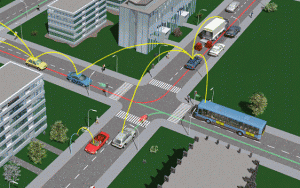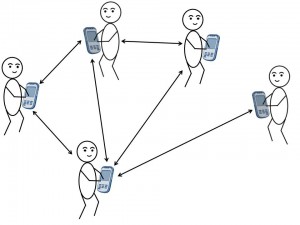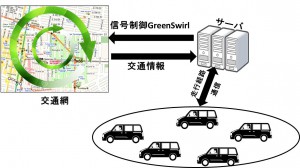Division for Foundations of Software led by Professor Minoru Ito in graduate school of information science at Nara Institute of Science and Technology, JAPAN, focuses on the following most innovative and edge-cutting network technologies:
1. Intelligent Transportation Systems (ITS)
 Fig.1 An example of ITS system (image is from this website).
Fig.1 An example of ITS system (image is from this website).
ITS aims to provide vehicle-to-vehicle (V2V) and vehicle-to-roadside communications so as to provide safety applications (like avoidance of car crash, notification of obstacles and safety message dissemination), traffic information (like, position of surrounding cars, car velocity, moving direction) and infotainment services (like games, video viewing, music sharing). For example, when a car got involved in an accident, it can directly communicate with other cars to inform them the accident so that others get alarmed and make corresponding decisions.
Mobile ad hoc networks (MANETs) represent a class of important wireless ad hoc networks with mobile users. Since the flexible and distributed MANETs are robust and rapidly deployable/reconfigurable, they are highly appealing for a lot of critical applications , like deep space communication, disaster relief, battlefield communication, outdoor mining, device-to-device communication for traffic offloading in cellular networks, etc.
Cloud computing refers to the delivery of computing services (like software and information) from invisible providers hidden in cloud as illustrated in Fig.3. Instead of possessing one’s own hardware or software for computing task, one just needs to access these computing services from service providers through internet.
 Fig.3 An example of cloud computing (image from wiki).
Fig.3 An example of cloud computing (image from wiki).
Regarding the above research topics, we focus on not only network applications that can be implemented directly in daily life, but also theoretical modeling that reveals the laws underlining network phenomenon that help us to better design network protocols.
Recent Awarded Works in Applications
1. DICOMO2014シンポジウム 優秀論文賞:“GreenSwirl:車両走行効率向上を目指した信号制御および経路案内方式”
研究概要:近年,大都市で深刻な交通渋滞が社会的問題となっている.特に渋滞を引き起こす原因の一つとして非合理的な交通信号サイクルがある.信号制御の技術としてGreenWaveが中国の複数の都市で実験されてきたが,結果は満足できるものではなかった.GreenWaveは一定速度で走行する車両は連続する交差点を常に青信号で通過できる技術である.GreenWaveの問題点として幹線道路のみに生成されるため,対向車線と横断道路の妨害、入口と出口の渋滞などを引き起こしてしまうことが挙げられる.この問題点を解決するために本稿では信号制御方式GreenSwirlおよび経路案内方式GreenDriveを提案する.提案手法では複数のGreenWave道路を渦巻き状に発生させ,GreenDrive案内方式で道路を走行する時間を見積もり,車両の平均走行時間を最小化する.提案手法の性能を評価するために交通流シミュレータSUMOを用いてシミュレーションを行った.ニューヨーク市マンハッタン島の道路網で車両の走行時間短縮効果を計測した結果,従来の手法と比べて提案手法は平均10〜70%程度,平均走行時間が短縮できたことを確認した.
2. DICOMO2014シンポジウム 最優秀プレゼンテーション賞 & 優秀論文賞: “地下街におけるスマートフォンの光を用いた避難誘導方式の提案”
研究概要: 停電した地下街では,壁や床等が見えず,避難者は唯一の目印である避難誘導灯を用いて避難することになる.しかし先行研究によると避難誘導灯を利用する避難者は2割程度であることがわかっており,避難誘導の役割を十分に果たしているとは言えない.本稿では,避難者の携えるスマートフォンの発する光(バックライトとフラッシュライト,総じてスマホライトと呼ぶ)を用いた避難誘導方式を提案する.避難者が床を見た際に,避難すべき方向(避難方向)に光の帯が流れるように見えるよう,各スマホライトを制御する手法を取る.すなわち,避難者は光が流れるように見えた方向に避難すればよい.提案するシステムは避難誘導装置と避難者の携えるスマートフォンからなる.避難誘導装置は避難誘導灯にビルトインし,電源は避難誘導灯の蓄電池を利用する.また,避難誘導が必要な状況をスマートフォンに知らせるために,避難誘導装置は無線LANを具備することとする.停電が発生すると,避難誘導装置は,避難誘導アルゴリズムの開始を知らせるパケット(開始パケット)を近隣のスマートフォンにブロードキャストする.開始パケットを受け取った各スマートフォンは,あらかじめ設定されている自律分散型アルゴリズムにしたがって,避難者から見て避難方向に光が流れるように見えるよう,スマホライトを制御する.提案手法を評価するため,避難者の目線による3D動画を用いたシミュレーションを行い,アンケートにより評価した.アンケートの結果,避難者が床を見ることで,光が避難方向に流れるように見えることを確認した.
Recent Achievements in Theoretical Modeling
1. Source Delay in Mobile Ad Hoc Networks
Source delay, the time a packet experiences in its source node, serves as a fundamental quantity for delay performance analysis in networks. However, the source delay performance in highly dynamic mobile ad hoc networks (MANETs) is still largely unknown by now. This paper studies the source delay in MANETs based on a general packet dispatching scheme with dispatch limit f (PD-f for short), where a same packet will be dispatched out up to f times by its source node such that packet dispatching process can be flexibly controlled through a proper setting of f. We first apply the Quasi-Birth-and-Death (QBD) theory to develop a theoretical framework to capture the complex packet dispatching process in PD-f MANETs. With the help of the theoretical framework, we then derive the cumulative distribution function as well as mean and variance of the source delay in such networks. Finally, extensive simulation and theoretical results are provided to validate our source delay analysis and illustrate how source delay in MANETs is related to network parameters.
2. End-to-End Delay Modeling for Mobile Ad Hoc Networks: A Quasi-Birth-and-Death Approach
Understanding the fundamental end-to-end delay performance in mobile ad hoc networks (MANETs) is of great importance for supporting Quality of Service (QoS) guaranteed applications in such networks. While upper bounds and approximations for end-to-end delay in MANETs have been developed in literature, which usually introduce errors in delay analysis, the modeling of exact end-to-end delay in MANETs remains a technical challenge. This is partially due to the highly dynamical behaviors of MANETs, but also due to the lack of an efficient theoretical framework to capture such dynamics. This paper demonstrates the potential application of the powerful Quasi-Birth-and-Death (QBD) theory in tackling the challenging issue of exact end-to-end delay modeling in MANETs. We first apply the QBD theory to develop an efficient theoretical framework for capturing the complex dynamics in MANETs. We then show that with the help of this framework, closed form models can be derived for the analysis of exact end-to-end delay and also per node throughput capacity in MANETs. Simulation and numerical results are further provided to illustrate the efficiency of these QBD theory based models as well as our theoretical findings.


